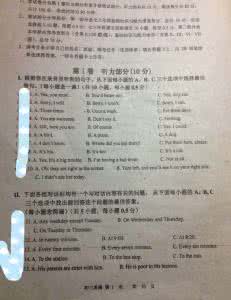2015—2016学年(下)高一年级期末考试
英 语 试 卷
第I卷
第一部分 听力(共两节,满分30分)
第一节 (共5小题;每小题1.5分,满分7.5分)
听下面5段对话。每段对话后有一个小题,从题中所给的A、B、C三个选项中选出最佳选项,并标在试卷的相应位置。听完每段对话后,你都有10秒钟的时间来回答有关小题和阅读下一小题。每段对话仅读一遍。
1. How long does it take the man to drive to the university during rush hour?
A. 25 minutes. B. 30 minutes. C. 50 minutes.
2. Where does this conversation take place?
A. In a hotel. B. In a restaurant. C. In a bank.
3. What should the man do next?
A. Prepare for the meeting. B. Make a phone call. C. Visit Dr.Carton.
4. What does the woman mean?
A. Stacey is a tough person. B. Nobody can replace Stacey.
C. The work is hard to do.
5. What’s the man’s trouble?
A. He had a bad meal. B. He received a wrong bill.
C. He couldn’t find the hotel.
第二节 (共15小题;每小题1.5分,满分22.5分)
听下面5段对话或独白。每段对话或独白后有几个小题,从题中所给的A、B、C三个选项中选出最佳选项,并标在试卷的相应位置。听每段对话或独白前,你将有时间阅读各个小题,每小题5秒钟;听完后,各小题给出5秒钟的作答时间。每段对话或独白读两遍。
听第6段材料,回答第6、7题。
6. Why does the woman dislike the first apartment?
A. Because it’s small. B. Because the surroundings are bad.
C. Because it’s expensive.
7. What do we know about the second apartment?
A. It’s near the company. B. It has no kitchen. C. It looks quite dirty.
听第7段材料,回答第8、9题。
8. What did the woman want to be at first?
A. An editor. B. A journalist. C. A TV host.
9. Where will the woman be working next month?
A. At a newspaper. B. At a TV station. C. At a computer company.
听第8段材料,回答第10至12题。
10. Where did the two speakers meet last time?
A. In a company. B. At a bookstore. C. On the road.
11.What can we learn about the man?
A. He seldom stays in New York. B. He works for a newspaper.
C. He will go to New York tomorrow.
12. Why did the woman go to Japan last month?
A. To learn computer. B. To go on a business trip. C. To visit the man.
听第9段材料,回答第13至16题。
13. When did the man go to India?
A. In 1960. B. In l965. C. In l961.
14. What has the man not been so far?
A. A novelist. B. An actor. C. A movie maker.
15. How many novels are mentioned in the conversation?
A. One. B. Two. C. Three.
16. Why did the man give up farming?
A. He was busy working on his novel. B. He had earned enough money.
C. He got married.
听第l 0段材料,回答第17至20题。
17. What is the woman talking about?
A. Bad behaviors. B. Gift-giving. C. Different customs.
18. What can we learn about gift-giving in North America?
A. The rules are complex. B. No gifts at a family party. C. It has a long history.
19. How do Japanese usually show their thankfulness?
A. By sending gifts. B. By drinking wine. C. By exchanging gifts.
20. What will the speaker probably talk about next?
A. The right time of gift-giving. B. The color of the wrapping paper.
C. The meanings of different flowers.
第二部分 阅读理解(共两节,满分40分)
第一节 (共15小题;每小题2分,满分30分)
阅读下列列短文,从每题所给的四个选项(A、B、C和D)中,选出最佳选项。并在答题卡上将该选项涂黑。
A
GROWING up in the Bay Area, I noticed that only those who could afford music lessons and expensive instruments were given access to music. This didn’t make sense to me. I created Lessons for Life to make learning music a right, not a privilege. We match underserved (服务匮乏的) students, who otherwise would not have access to one-on-one music instruction, with volunteer tutors from high schools and colleges.
Lessons for Life started out as a community service project in high school. I was intent (急切的) on making music a reality for students. I remember receiving an email from a young girl, Claire, requesting to participate in the program.
Claire had a disability and she described how listening to music made her feel connected to the world. She had always wanted to play the violin, but her school didn’t have a music program. Claire planned on taking three buses from her home in Oakland to San Francisco to take lessons. At that moment, I understood I had to turn Lessons for Life from a community service project into a non-profit.
At first, my community laughed at this idea. Teachers and friends commented that I was simply too young. This only sparked (激发) my ambition. If I could do it, I could show other young women that they can start meaningful companies and non-profits too. In that moment, I decided to be a leader and a role model, making the impossible look possible.
After five years, I am leading a non-profit and am a part of a revolution in music education. Natalie, the first student I instructed, is now in the Youth Symphony and plans on becoming a professional musician. Other students share similar stories to Natalie’s. We are teaching our kids not only how to play music, but also how to take a chance and create.
Yet still, they began their journeys.‖ You are ready for greatness. The only risk is not trying. In my journey of leadership, friends of all ages have asked me how they too can build meaningful and successful careers for themselves. I tell them that only they can turn themselves into leaders. As Mike Dooley once said, ―The one thing all famous achievers in any field have in common is that they all began their journeys when they were none of these.
21.What can we learn from the article about Lessons for Life?
A. Only those who could afford music lessons and expensive instruments could attend it.
B. It was intended to help students who couldn’t afford one-on-one music instruction.
C. The author loved music so much that she started teaching music to disabled people in her
community.
D. It started out as a high school non-profit with volunteer tutors from high schools and
colleges.
22. What was the author’s reaction to the ridicule and disbelief around her?
A. Angry, then she started her company right away.
B. Defeated, which meant that she gave up the idea for a while.
C. Unsure, but she continued to make the impossible possible.
D. Determined to achieve her goal and to show that others can do it too.
23. What are Paragraphs 3-5 mainly about?
A. How the author has succeeded in her career.
B. Why the author decided to be a leader.
C. When the author began leading a non-profit.
D. How Claire and Natalie influenced the author.
24. According to the author, how can you build a meaningful and successful career?
A. Look before you leap. B. Care about what others need.
C. Just do it, and you can make it. D. Be passionate about your cause. B
ONE morning last week I looked out of my study window and saw that it was a fine day. No, it was a glorious (极好的) day: the sun shone down from a sky with not even a single cloud.
But later that day, hard at work at my desk, I heard a loud drumming noise on the roof. Turning to the window, I saw that the sky was now the color of charcoal (木炭). Rain was beginning to fall; two minutes later the rain became hail (冰雹); at some point, the hail became snow. Rain, hail or snow, it was all wet, making rivers of water. This story will give you some idea about weather in Britain. It’s extremely variable. Go ahead with your picnic in the local park by all means, but don’t assume that because the sun is shining now, it will be when you open your pack of sandwiches; better take an umbrella, just in case.
The weather in Britain is by no means always bad. The weather can just seem a lot like a person who has a lot of mood swings.
This is one of the biggest reasons why the British talk so often about the weather: it’s handy. Wherever there are strangers standing or sitting close together, and talk cannot be avoided, the conversation focuses on the weather: ―Yes, the weather has been good, hasn’t it? Three whole days of sunshine this May!‖ or ―What shocking weather we’ve been having!‖ The unreliability of the weather is something that every Brit can agree on. That makes it a safe topic of conversation.
Thus, the weather’s unpredictability is actually a plus for the British, a very useful bit of our culture. Even those with different opinions on everything else in the world, such as the current argument in the UK about membership of the European Union, can talk about the weather without it leading to a shouting match. Long live rainstorms in mid-July!
25. The writer wrote the article mainly to ______.
A. describe his own experiences of the different weather in Britain
B. remind people to take an umbrella whenever they have to go out in Britain
C. prove the uncertainty of the weather in Britain
D. describe the weather and the way people talk about weather in Britain
26. The main characteristic of British weather is ______.
A. changeability B. stability C. lack of sunshine D. continuous rain
27. The British often start conversations by talking about the weather because ________.
A. they seldom trust the weather forecast
B. the variable weather is a safe topic of conversation
C. they are all interested in predicting weather
D. they like complaining about the terrible weather
28. It can be inferred from the article that the author holds a(n) ________ attitude toward the weather in Britain.
A. negative B. critical C. indifferent D. positive
C
WHEN the White House announced that Malia Obama, the older daughter of US President Barack Obama, would wait until 2017 to enroll in Harvard and would take a gap year in the meantime, a lot of Americans were confused. But the White House didn’t say what Malia Obama would do during the year she’s taking off.
Gap years are so popular in Britain that more than 200,000 students take them every year. However, they are virtually unknown to many students in the US. Only about 1 percent of graduating seniors, or about 30,000 American students, decide to take a year off between high school and college.
Gap years, as defined (定义) by most US colleges, are structured (规划好的) educational periods of travel, volunteering or other kinds of learning through experiences. They usually have to be approved by the colleges students plan to attend, and more American students have started to take gap years.
According to American Gap Association surveys, there was a 22 percent increase in students taking gap years in 2015 over the previous year.
While many colleges, and particularly public universities, don’t allow students to defer enrollment, Florida State University has begun encouraging its freshmen to take a year off from their studies in order to get some extra maturity and new experiences.
―We know very clearly now that gap years can be an educational experience that changes you completely,‖ said Joe O’Shea, president of the board of the American Gap Association. ―They show an increase in determination. Gap years help increase students’ focus while their identities and future plans take shape.‖
Just ask Karis Engle, who spent a year with a charitable organization in Haiti at age 18. The experience has
made her realize that she wants to help others. Engle, now the president of The Glades Initiative, a non-profit organization that helps with food security in communities in southern Florida, said the immersion (沉浸) in a very different culture completely changed her worldview.
By the time she entered Bethel College in Kansas a year later, her life had changed.
―I felt like I was different from most people there. I knew clearly what I wanted to study, which was international development with an emphasis on social work,‖ Engle said.
She believes gap years are good ways for young people to get away from their comfortable lives, family expectations and pressures from society to see their lives from a new angle.
―It helps you choose your path,‖ she said, ―instead of letting it choose you
29. According to the article, which of the following statements is TRUE?
A. Malia Obama is going to go backpacking through Europe with her friends during her
gap year.
B. Most public universities in America encourage students to take a gap year.
C. Students learn through their experiences by traveling, volunteering etc during gap years.
D. American students can take a year off whenever they want.
30. The example of Karis Engle is used to show that ______.
A. students have a new worldview after taking a gap year
B. gap years can help students become better leaders
C. students can experience what it is like to be away from comfortable lives
D. gaps years help students become more clear about their future
31. The article was mainly written to ______.
A. explain why Malia Obama wants to take a gap year
B. explain what a gap year is and what its benefits are
C. show the growing popularity of gap years in America
D. encourage Chinese students to take a gap year
D
WHEN you get hungry, do you find yourself making poor decisions? Well, it turns out that this is because of a hormone called ghrelin (饥饿激素).

It is released when you are hungry and has a bad effect on impulses (冲动) and making decisions, according to a recent study at Sahlgrenska Academy, part of the University of Gothenburg in Sweden.
―For the first time, we have been able to show that increasing ghrelin to levels that are seen when hungry causes the brain to act impulsively and also affects the ability to make rational decisions,‖ Karolina Skibicka, a member of the teaching staff at Sahlgrenska Academy, told the Science Daily website.
Impulsivity is complex, according to the website, but impulsive choice basically means not being able to resist the temptation to take a reward now instead of waiting until later.
You may sometimes eat a bag of chips even though you know that you’re going to have dinner soon, for example. This type of problem was seen in the rats used in the study.
The rats were trained to be rewarded with sugar when they did something like pressing a lever (杠杆) – or instead, they could be rewarded only when they stopped themselves from pressing the lever (―no-go‖) when the right signal, like a flash of light or a buzzing sound, was given.
When rats could not stop themselves from pressing the lever when the ―no-go‖ signal was given, it was seen as a sign of impulsivity. Researchers found that rats given ghrelin directly into the brain were more likely to press the lever instead of waiting, even though it caused them to lose their reward.
The ability to wait for a greater reward later measures impulsive choice. For example, you can overeat fattening foods to feel happy right now or choose to eat healthier. Researchers at Sahlgrenska Academy found that higher levels of ghrelin stopped the rats from being able to wait for the greater reward.
The study also showed that increased levels of ghrelin even caused long-term genetic changes in the brain parts that are connected to impulsivity and decision making. The same type of changes can be seen in brains with attention deficit hyperactivity disorder (ADHD) (注意力缺陷多动障碍) and other psychiatric disorders (精神疾病), reported Science Daily.
―The ghrelin receptors in the brain can be a possible target for future treatment,‖ said Skibicka.
32. According to the article, in the study at Sahlgrenska Academy, ________.
A. the rats could only get their reward when they pressed a lever
B. when ghrelin in the rats’ brains increased, they could wait for the right signal
C. when ghrelin in the rats’ brains increased, they were more likely press the lever
D. when ghrelin in the rats’ brains increased, they were eager to get the sugar
爱华网www.aIhUaU.com网友整理上传,为您提供最全的知识大全,期待您的分享,转载请注明出处。 爱华网
爱华网



